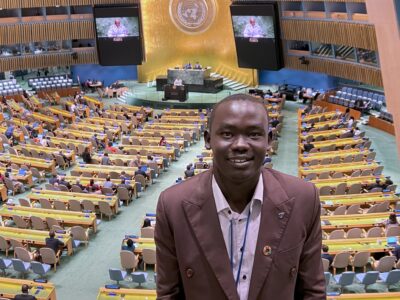This story is part of a series celebrating the work of women at the Earth Institute, in honor of International Women’s Day on March 8, 2022. Read more about the day and our related blog posts here.

For over ten years, Haein Shin has shaped and informed classrooms around the world as an education professional. Her work has ranged from monitoring and evaluating the needs of secondary schools in Myanmar to supporting educational program management in ten countries in sub-Saharan Africa.
Shin was first motivated to pursue international educational development following her hands-on experience working with communities in Morocco as a youth and community educator in the Peace Corps.
“I saw the value of planning and implementing programs with learners, and the huge potential that those programs have to further behavior changes and knowledge sharing,” she said.
At Columbia Climate School’s Center for Sustainable Development, Shin develops and curates content around environmental awareness, digital and financial literacy, and employment readiness — especially for women and girls — based on the U.N.’s Education for Sustainable Development framework and the Sustainable Development Goals.
For International Women’s Day, Shin spoke about how education contributes to the advancement of a more equitable future, and the ways in which she finds meaning in her work.
The following interview has been edited for clarity and length.
What is the role of educational planning, and why is it important?
Educational planning is crucial because it is a process through which a system and its many parts can intentionally reflect on specific educational needs and create a roadmap of concrete actions. I see educational planning as a tool to navigate how to make education offerings more equitable for diverse populations in various spaces and places. It can facilitate the increased exposure and inclusion of content that then helps raise groups and generations of learners. When [these learners] are equipped with the knowledge they need to take action within their schools, homes, communities, and beyond, they can contribute to building a more inclusive and sustainable future.

What are the problems you are trying to solve for as an education professional?
Despite education being a basic right, it is still missing for many learners in terms of access and quality around the world. My work tries to provide that access while promoting and advocating for educational opportunities that are relevant, useful, and meaningful for the growth and development of the learner — personally, economically, and professionally. Depending on the context, the educational offerings can look very different. They can take the form of basic literacy, numeracy, and digital literacy; trainings for teachers, employment readiness, and life skills; or discussions and forums on climate and environmental education.
Could you speak a bit to how educational planning, digital and financial literacy, and employment readiness intersect with gender, specifically?
Unfortunately, the gender gaps that disadvantage women are still very present. For example, women are underrepresented in areas like the technology workforce, in part because 90 percent of jobs today require a certain level of digital skills, according to the European Commission. Financial literacy and confidence are also lower among women than men. Educational planning can acknowledge these inequalities and begin to address them through educational offerings that are targeted to populations and locations.
Do you have a general process or philosophy for how you develop educational content?
This may seem like an obvious point, but I emphasize it due to prior mistakes that I’ve seen and sometimes made myself: Let the content and expressed needs come directly from the community and then co-create. There is still value in pitching ideas from various sources and people, but ultimately, the content needs to be owned by the community for it to be successful.

What are some of the challenges that you face as a practitioner in this field?
Even with specific plans, continued access to educational programs has always been a challenge — one that is usually linked to education funding. Education spending is still quite low in many of the countries where the Center for Sustainable Development works, and despite great plans, limited funding hinders the sustained development of programs, the continual development of content, and the populations that we are able to reach.
Are there developments in education that you are particularly excited about?
I think the COVID era has shown not only the potential for technology in education but also the need for real connections that cannot be replaced by technology. To that end, I am excited about the various mediums growing in education that can help improve access to technology, as well as the growing recognition that fundamental components of learning and learner development — such as social and emotional skills, life skills, and connections between educators and learners — are a critical part of the learning community.
As you have moved throughout your career, how have you found meaning in your work?
In the end, I think it comes down to individual students. I remember talking about gender issues — harassment, specifically — with a youth group in one of the programs. A normally playful class went completely silent when [the students were] asked to consider what it would be like if an immediate family member was a victim to harassment. Their attitudes in thinking about something they brushed off as a norm or commonplace changed over the course of those discussions. Planning and program implementation can take place at both the local- and micro- level as well as the policy- and macro-level, but the place I find meaning is in how it can influence individual learners.
In what ways has that meaning changed or evolved?
I think the meaning I find in my work has stayed the same but what has changed is realizing how the influence of education needs to take place both individually and collectively. It’s similar to how an individual may choose to wear a mask or to reduce their carbon footprint, but a broader policy or rule is what makes for more effective change. We need broader educational policy that supports collective learning.



